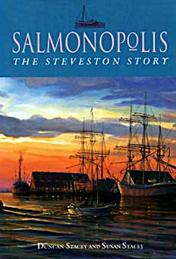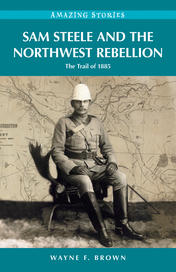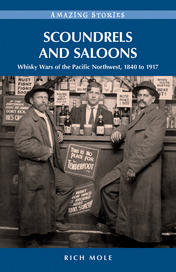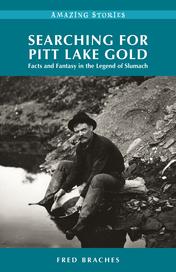Canada

Native women working in the canneries were often hired and paid by the Chinese contractor. Some women were regular employees who repaired nets; others were strictly seasonal staff, the spouses of the fishermen employed by the cannery. The average working day was ten hours, but it could be longer at the height of the season. In the early years of the industry, before gillnet webbing was made by machine, Native women were employed before the fishing season as knitters. They were given a certain quantity of linen twine to be made into the mesh size required by fishery regulations and to the depth desired by the cannery. They held a wooden gauge (to ensure standard size) in their left hand and their shuttle or needle filled with twine in the right. Each net took a few days to complete, after which it was measured; if satisfactory, a new allotment of twine was issued.
During the canning season the women worked mainly as slimers and occasionally as slitters, fillers or can wipers. While their mothers worked, the Native children might pile the filled salmon cans or play on the beach under the cannery floor when the tide was out. Here they often found knives and whetstones that had fallen through cracks in the floor, and they sought rewards for returning them.
While they were at the cannery houses, Natives cooked over open fires, either inside the building or out. Many varieties of fish made up their principal food source, including salmon, sturgeon, oolichans, and shellfish such as clams and cockles. When there was a surplus of salmon at the canneries, canners offered the extra to the Natives, who cured it in their smoke houses or salted it in a strong brine. They also preserved oolichans. There were special treats for children, such as the uncooked spinal cord from the sturgeon their parents occasionally caught in the Fraser. They also made a simple bread from flour and water, baked in an open pan, and their meals were accompanied by butter, greens, wild rhubarb and berries gathered from fields around Steveston.
Clothing was generally simple and convenient. Women wore dresses that could be pulled over the head without need for fasteners. A friend had the woman stoop over, laid a newspaper on her back, and cut the outline of her figure, which was then transferred to fabric purchased at a Steveston store. Young children often wore nothing more than a cotton shirt, and neither they nor their mothers were accustomed to wearing shoes, stockings, coats or hats.
Men and children sometimes swam in the river, but women rarely did and thus were more prone to vermin infestation. Missionaries visiting the Native camps helped procure medical help for other conditions as they became evident. Deaths were common in summer camps and the Natives frequently wanted to take the bodies back to their reserves at the end of the season. They made coffins from lumber found around the canneries and stored them, sometimes in trees or small "houses," until they went home. Vandalism brought an end to this practice, and they started taking their dead to Vancouver; but the custom provided a vivid memory for many Steveston pioneers,
The Natives always brought their dogs along with them and sometimes, at the canneries, made pets of hair seals who lived at the mouth of the river and were the bane of the fisherman's life, stealing salmon from the nets or becoming entangled in them. European fishermen generally knocked them over the head and threw them back into the water; Native fishermen often brought them back for the children to play with.
The seal was fed salmon beads from the cannery waste, and within a few days it became tame enough for the children to play with, cautiously at first, but with increasing familiarity. It eventually became tame enough to be taken out in a small canoe to swim playfully about with the children. It frolicked in and out of the canoe with them until the canoe was swamped, and then the children and the seal tumbled out and returned to the camp, the seal squirming its way up the bank.
TWO sounds 1 have never forgotten are the seal's cry at night and the song of the Indian inducing fish to swim into his net. The cry of the seal closely resembled that of a dreaming infant; the Indian's song was a composition of his - a tune of a few bars, sometimes with improvised words. On a quiet moonlit night, with the stillness so absolute as to be heard, the cry of the seal or the song of the Indian broke through with a suddenness both weird and startling.
(T. Ellis Ladner, Above the Sandheads, 1979)
In the early years the canners were dependent on the Natives for both fishing and cannery labour. As the Japanese entered the industry, however, canners preferred them as fishermen, finding them more productive and less likely to take sudden leave of the canneries in favour of other occupations, such as harvest work. When Steveston suffered the double calamity of losing several canneries to fire and losing large salmon runs to a variety of environmental changes, the Natives stopped coming in great numbers during the salmon season, staying closer to their upcoast homes where other canneries were being built. By 1918 only one Steveston cannery used Native labour in any significant number.
Steveston's summer population was a unique ethnic mixture, which was a distinctive feature of the little farming village and a source of great fascination to outsiders.
"Strange Fascination"
The date of my visit [19011 synchronized with the great annual rush of the fish from the sea up the river to deposit their spawn in the flowing water that has had the chill taken off it by the hot summer sunshine. Helter-skelter, crowding together with an eagerness to obey natural law which is as cosmic as the daily rising and shining of the great luminary on the soft Pacific waves, they come with a rush. . .
We drove seventeen miles to Steveston to see the canning. There are twenty-nine canneries at this queer town of plank streets, wooden houses and big canneries that straggle all along the river front. It is alive and kicking for two or three months in the year - the rest of the time it sleeps, and the visitor then wanders through deserted thoroughfares and shut-up canneries. Our drive took us . . . to a region of fertile farms, off which a big hay harvest had just been reaped; and at last, over a mile and a half of the straightest and dustiest road it has ever been my lot to travel, to the long straggling Steveston canneries. . .
The canneries are great sheds opening on one side of the river; and going into their semidarkness out of the sunshine we became conscious of the performance of a great provision industry by the agency of blue-bloused, sallow Chinamen of all ages. First, however, let us walk to the river front, where the boats are coming in with their cargoes of fish. Soon we are looking out on the bright-glancing, drab water - for the Fraser is turbid. There are many sailboats - sixteen or eighteen feet long, perhaps; broadish in the beam, strongly built. They go out into the river, and from them nets are cast, into the meshes of which the eager fish rush and are caught by the gills. The principal work this year seems to be taking the fish out of the nets and knocking them on the head to stop tail-wagging.
Twelve and a half cents each the men get for their fish. A moment or two ago at the hotel you had seen one of them give the landlord $250 to take care of for him. He said he had earned it during the previous week.
We turn to the interior of the cannery, and find ourselves standing by a great heap of salmon. The heap is about forty feet long and ten wide. There may be ten or fifteen thousand salmon there. Flanking this is a long, wet, fish-mongery- looking bench, at which a solemn old Chinaman is at work with a sharp knife. It is rather wet and slippery everywhere, so that you walk carefully and there is such am anphibious atmosphere about that you might expect to meet a mermaid.
But watch Allee Knifee. Is it by magic that the fish's head comes off with a dean cut; then his tail; then his big back fin, and his side fins? The head is pitched through a hole in the board that fronts Allee Knifee, the tail through another, the body through a third. Facing the old master of the knife, on the other side of the board, is a long tank of water, and here a dozen Indian women stand cleaning the fish - for Indian women clean salmon by immemorial instinct. Chinese labourers are perpetually carrying the cleaned fish to a most ingenious machine, that goes by power, and saws the salmon up into lengths just the height of the ordinary salmon tin.
It is entertaining to watch the thin circular saws, gauged to the proper distance apart, on the axle, cut up the fish into short lengths, and roll it down a shoot. A score of Chinamen and Japanese are packing these short lengths of salmon into cans; rolling the red fish into cylindrical form, and jamming it into the receptacles with much art. The cans are then weighed, and if they do not contain the prescribed quantity, more fish is jabbed in. These full cans are then carried in trays to another most ingenious machine into one part of which they are fed, while into another part a supply of can tops is kept going. The machine puts the tops on the cans; that is, it pushes them on tight. If one of them misses getting its cover, a Chinaman or a Japanese seizes a top and pushes it on by hand.
Still, however, they require soldering. For this another clever arrangement is put into requisition, whereby a succession of cans roll down an incline. They roll a-tilt, on the circular edge of their tops, the cylindrical portion of the can being at an angle of forty-five degrees. They also roll through a thin stream of molten solder, which is kept hot by fires underneath it. Before they start to roll they pass under dropping acid (technically known as Take') which acts as a flux for the solder. They emerge with their tops soldered on air-tight. Then they are placed in a boiling vat for an hour and ten minutes. On coming from this ordeal a small hole is pierced in the top of each can, which allows of the escape of the imprisoned steam and moisture. This hole is immediately soldered up again and packing is complete. When the cans are cold they will be japanned, labelled, and packed in cases.
There is a strange fascination about this haunt of industry - this assemblage of continuously working Celestials and Japanese and stolid, broad-faced Indian women. There is no chatter; you scarcely hear a word spoken from the time you go in till you come out, for strict attention to business is characteristic of these Mongolian workers and their confreres. But here and there, leaning up against a bench, is a well-worn tin opium pipe. . .
It was lamentable to see the great overplus of salmon at the canneries this year. I saw heaps of fish that were refused by the canners simply because they had a greater supply than they could pack . . . At present large quantities of fish have to be thrown away or used as manure. The abundant catch of this year means much to Vancouver. It is so much wealth cast up by the sea into the outstretched hands of these British Columbia workers.
(Bernard McEvoy, From The Great Lakes to the Wide West, 1902)

A MYSTERIOUS NEWCOMER
One Salt Spring islander greatly influenced almost everyone and everything around him. Not everyone liked Harry Wright Bullock, and few understood him, but he was truly larger than life.
The single, rich, twenty-six-year-old Englishman who came to Salt Spring Island in 1892 must have intrigued islanders. Bullock was short (about 5'8"), broad, bespectacled, and balding, with a large beard and a round kindly face. Donald "Goodie" Goodman, who worked for Bullock from 1922 to 1926, said his employer "was a man of very much regular habits, including a fair amount of eating, usually about five meals a day, and he showed it all right."'
Bullock's somewhat mysterious quality led many people to exaggerate when discussing him. His dress and demeanour were consciously that of an upper-class English gentleman. Almost every photo or description portrays him formally dressed in a starched white shirt, tie, vest, black waistcoat or long black frock coat, and satin top hat. He even kept his beard black and shiny with a product called Beardblack. In the frontier community of latenineteenth-century Salt Spring, where most people survived by hard physical labour, Bullock's fanciful appearance sometimes inspired far-fetched stories of outlandish behaviour. Bullock's wealth, lifestyle, and eccentricities - he liked islanders to call him "The Squire" - invited discussion and anecdote.
Bullock, the second son of a wealthy Bristol family, was born in 1866 near his mother's home of Chalfont, Buckinghamshire. His family provided ample financial support when he left for the colonies. Denise Crofton, a frequent guest in Bullock's home, remembered hearing that Bullock was in love with his brother's wife and left England to avoid painful encounters.
For five years, Bullock rented two rooms at Stevens Boarding House and lived there while his house was being built. Anne Stevens was a good cook, and the boarding house at Central was next door to St. Mark's Church, very important to the devoutly Anglican Bullock.
Bullock purchased land on the lake that now bears his name and hired Reid Bittancourt to build a twelve-room mansion, which reputedly cost $2000. Fruit and nut trees were planted almost immediately.
One of Bullock's first housekeepers was Miss Hind, a former matron of Victoria's Protestant Orphans' Home, who came to Salt Spring in 1903. Mary Palmer replaced her three years later.
Over the years, Bullock's house grew. Bill Palmer, his employee for years, said the house had ten bedrooms, a dining room, a drawing room, a huge hall, Bullock's den, a sitting room, a small dining room where the household staff ate, and a large kitchen. Donald Goodman remembered that Bullock had a furnace in the entry hall, "which only a bachelor would do, because no wife would ever arrive and let him get away with it." He said the house contained "a helluva lot of antiques," and the walls were covered with valuable paintings. The indoor plumbing, perhaps the first on the island, required an unsightly network of exposed pipes on inside walls.
Bullock was a knowledgeable farmer, but left most farm work to Japanese labourers. Each year, his 300-acre (121 ha) farm produced about two thousand boxes of apples, plums, pears, and cherries - 80,000 pounds (36,288 kg) of large, high-quality fruit. Bullock also produced cream from his Jersey cows, pork, poultry, lamb, garden crops, and honey from his hundred or so beehives. Ham and fish were cured in a smokehouse.
Bullock's state-of-the-art equipment included one of the island's first tractors in about 1922, a gasoline generator, and a steam engine to thresh grain. Day-to-day operations were overseen by a succession of competent managers. The first, in 1905, was Keith Wilson, Rev. E.F. Wilson's youngest child. Three years later, Bill Evans came to work on the farm and eventually replaced Wilson as estate manager. Bullock built a house for Evans and his wife, Nellie Dowson, who arrived from England in 1912. When Evans left to manage a farm at Duncan in 1917, Bill Palmer took over.
BULLOCK'S BOYS
After 1900, Bullock always hired a couple of twelve- to sixteen-year-old boys to care for his house and property Most came from the Protestant Orphans' Home in Victoria. After Mary Palmer retired, the senior boy would serve as cook-taught by Bullock, himself a good cook-and the junior as houseboy The cook was also responsible for preparing the shopping lists. The houseboy cleaned the house, served at table, and did the dishes. In winter, the boys cleared snow and brought in well water, as Bullock Lake was too boggy to provide drinking water; in spring, they helped plant the gardens.
Each boy received room and board plus $10 a month in his first year, with an increase of $2 a month for each successive year. A boy needed to buy only clothing from his wages, as Bullock supplied everything else. Donald Goodman remembered Bullock investing $125 in a radio just for the boys' use.
Bullock was very strict with his boys, insisting on proper behaviour and dress (he dropped the requirement for elaborate uniforms after World War 11). Although Palmer said his employer occasionally carted him and made the boys "toe the line," Goodman said that Bullock never really mistreated them. Still, Bullock's class biases were apparent in his "upstairs-downstairs" household. He ate only in the dining room, for example. Occasionally he would break his own rules, Palmer recalled, by having a cup of tea in the kitchen. He also did not believe that working-class children required schooling, so his boys never attended school. The only exception was Bill Palmer, who attended a Salt Spring private school and completed Grade 13 in Victoria, perhaps at his mother's insistence.
Donald Goodman recollected one Bullock failing: "One of his bad faults was that he couldn't tolerate seeing you without something to do." The boys started work at 8:00 or 8:15 a.m. but dragged it out until 9:00 p.m., "because if he caught you without a job, he'd find a new one for you.... When he went out, we'd finish up within ten minutes and be gone." It was the only way they could get time off.
Some felt that, when Bullock was older, the boys took advantage of him, as Donald Goodman reported:
"[Bullock] was foolish to an extent, especially years after I left. He was loanin' the kids money with no thought of ever getting it back. . . They could touch him for 20 dollars any old time they wanted. And he'd give it to them and smile. He knew he wasn't gonna get it back, but he'd still loan it."
Over the years, Bullock hired as many as sixteen boys from the orphanage. Bullock's boys must have learned valuable skills from him, because most did well after they left the estate. Today people might suspect the motives of a man who had such close involvement with young boys. However, no hint of scandal attached to the man in his own day, and Bullock's boys continue to speak highly of their mentor.



Scoundrels, Dreamers & Second Sons





